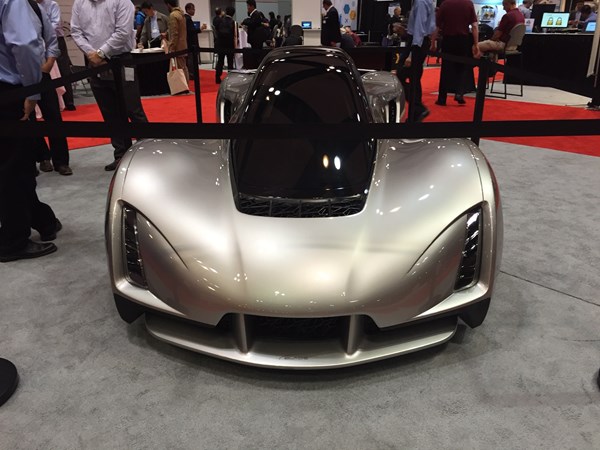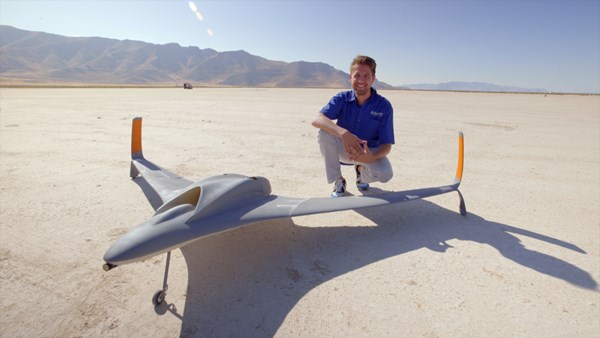3D printing continues to mature
While traditional applications such as prototyping is still growing, it will be augmented with a variety of new applications.

It’s safe to say that 3D printing is now a household name. The global 3D printing market is estimated to reach at least $7 billion by 2025. While traditional applications such as prototyping continue to grow, it will be augmented with a variety of new applications. During the 3D Printing USA Conference (Nov. 18-19, Santa Clara, CA, US) hosted by IDTechEx (Cambridge, UK), composites was featured in several presentations.
IDTechEx believes that the hype around consumer printers is dying out but will soon be replaced with hype around 3D-printed critical components in commercial airliners, fully printed rocket engines and more.
Kevin Czinger, founder and CEO Divergent Microfactories (Palo Alto, CA, US), discussed the company’s Blade, the world’s first 3D-printed supercar. Divergent Microfactories’ technology centers around its proprietary solution called a node: a 3D-printed aluminum joint that connects pieces of carbon fiber tubing to make up the car’s chassis. The company says the node solves the problem of time and space by cutting down on the actual amount of 3D printing required to build the chassis and can be assembled in minutes. The weight of the node-enabled chassis is up to 90% lighter than traditional cars. Divergent Microfactories plans to sell a limited number of high-performance vehicles that will be manufactured in its own microfactory.
Czinger said the automotive industry has an urgent need for a new production system that builds cheaper, lighter and greener cars with less capital risk and far greater speed of innovation.
“3D printing is ushering in a 21st century industrial revolution aimed at encouraging innovation in manufacturing while reducing its harmful environmental impacts,” Czinger said.

According to Dan Campbell (pictured) from Aurora Flight Sciences, the new UAV is believed to be the largest, fastest, and most complex 3D-printed aircraft ever produced. (Photo credit: Stratasys).
Last week, Stratasys (Eden Prairie, MN) announced that it had teamed up with Aurora Flight Sciences (Manassas, VA) to create what the company believes is the largest and fastest 3D-printed unmanned aerial vehicle (UAV) ever produced. The project went from concept to first flight in less than nine months. Aurora Flight Sciences wanted to show that it was possible with this technology to build a mission-unique aircraft, optimized for a specific use case, Scott Sevcik, aerospace and defense business development at Stratasys, told CompositesWorld. They did the modeling to accomplish that and determine the optimal outer mold line for the vehicle. Stratasys then worked with a company called Optimal Structures to explore the internal structure that would support the exterior with as little mass as possible. Sevcik said the resulting geometry couldn’t be built without additive manufacturing.
“Most of the design optimization work happened through the second quarter, and then we started printing parts and iterating physically. Because almost the entire vehicle was printed, we could make a significant design change and have a new part in a few days. Traditionally this would have taken weeks to tool up for a new part and produce it. Because of that ability to iterate so fast, and without tooling costs, there is significantly lower risk moving to physical iteration more quickly. So you start building faster, you can iterate the design faster, and finally you produce the final flight vehicle faster,” he said.
The large, lightweight pieces such as the wings and fuselage were built with a material called ASA, a production-grade thermoplastic. ASA is similar to ABS in many properties, but it is more UV stable, stronger, and allows for very sparse, hollow parts. There was a composite piece on the vehicle—a thin carbon fiber spar reinforcing the wing. The vehicle is a little more than 9ft in span, and about 30lb in dry weight.
Sevcik believes that more than any other industry, aerospace is providing a significant pull on the manufacturing capability of 3D printing.
“The relatively low volumes, the high complexity and the willingness to innovate in order to reduce vehicle weight really make 3D printing ideally suited for their needs—we’ve got to keep up with them,” he said. “The technology today has enabled aerospace manufacturers to start printing assembly aides, fixtures and composite lay-up tools. It’s enabled them to print interior components for commercial aircraft, ducts for launch vehicles, and structures for small UAVs.”
“With this project, we’re showing that the capability is continuing to advance and the technology is continuing to mature,” he said. “We couldn’t have built a vehicle this big, strong, or complex a few years ago. We can take a radically different approach to designing and building a vehicle this size today. The concepts and techniques are scalable, so I’m excited to see the trend continue as we improve processes and introduce stronger materials, and to consider what we’ll be able to do in the coming years.”
Related Content
Cryo-compressed hydrogen, the best solution for storage and refueling stations?
Cryomotive’s CRYOGAS solution claims the highest storage density, lowest refueling cost and widest operating range without H2 losses while using one-fifth the carbon fiber required in compressed gas tanks.
Read MoreComposites end markets: Automotive (2024)
Recent trends in automotive composites include new materials and developments for battery electric vehicles, hydrogen fuel cell technologies, and recycled and bio-based materials.
Read MoreTPI manufactures all-composite Kenworth SuperTruck 2 cab
Class 8 diesel truck, now with a 20% lighter cab, achieves 136% freight efficiency improvement.
Read MoreSMC composites progress BinC solar electric vehicles
In an interview with one of Aptera’s co-founders, CW sheds light on the inspiration behind the crowd-funded solar electric vehicle, its body in carbon (BinC) and how composite materials are playing a role in its design.
Read MoreRead Next
“Structured air” TPS safeguards composite structures
Powered by an 85% air/15% pure polyimide aerogel, Blueshift’s novel material system protects structures during transient thermal events from -200°C to beyond 2400°C for rockets, battery boxes and more.
Read MoreAll-recycled, needle-punched nonwoven CFRP slashes carbon footprint of Formula 2 seat
Dallara and Tenowo collaborate to produce a race-ready Formula 2 seat using recycled carbon fiber, reducing CO2 emissions by 97.5% compared to virgin materials.
Read MorePlant tour: Daher Shap’in TechCenter and composites production plant, Saint-Aignan-de-Grandlieu, France
Co-located R&D and production advance OOA thermosets, thermoplastics, welding, recycling and digital technologies for faster processing and certification of lighter, more sustainable composites.
Read More






















